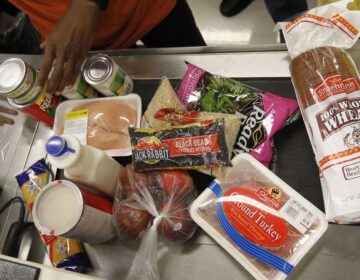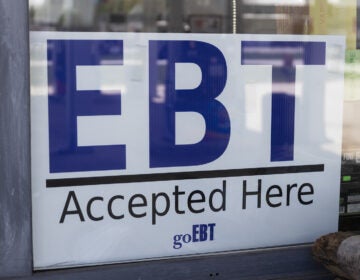Poorest Pa. families struggle through holidays as cash welfare stuck at 1990 levels
Pennsylvania’s grant amounts have been stagnant since George H.W. Bush was president. Meanwhile, the state is sitting on $400 million in program reserves.
Listen 4:07
23-year-old Carissa Coolbaugh talks about her experiences as a Temporary Assistance for Needy Families (TANF) recipient Dec. 17, 2019, while at her home in Hanover Township, Luzerne County, Pennsylvania. (Matt Smith for Keystone Crossroads)
Christmas is Carissa Coolbaugh’s favorite holiday.
The front door of her cosy rowhouse in Hanover Township, just outside of Wilkes-Barre, is covered with red and green wrapping paper. Inside, two Christmas elves sit on a shelf, embroidered with the names of her boyfriend’s daughter and her two-year-old son, Malachai.
Coolbaugh is committed to making the children’s holiday special. Last month, when she had to choose between the $60 water bill and buying presents for them, she skipped the bill.
“If I would have chosen the water bill, he wouldn’t have had no presents underneath the tree,” she said. “It’s crazy when there are holidays. It’s hard.”
As a single mother, Coolbaugh, 23, isn’t a stranger to this kind of decision. She relies on Temporary Assistance for Needy Families (TANF), a federal welfare program that provides about $700 million a year to Pennsylvania to support poor families. Coolbaugh applied for the benefit after a car crash led her to lose her job as a shift leader at Dairy Queen. She receives other government benefits too — with rent subsidized by a housing voucher, her son enrolled in a subsidized child care program, and much of her food cost covered by the Supplemental Nutrition Assistance Program, commonly called food stamps.
For everything else, she uses her monthly TANF payment of $316. That leaves little room for things like holidays, or bad luck.
“If the car breaks down that’s a huge problem for me,” Coolbaugh said. “I had to go without [my] car for about three months…I had to save up money for it.”

Advocates say there’s a clear way to improve the lives of TANF recipients like Coolbaugh: raise the monthly grant amount. Right now, the maximum amount a family of three — the most common scenario — can receive in Pennsylvania is $421. That number hasn’t changed since 1990, including years under a previous federal benefit program. Since then, with inflation, the stipend has lost about 50% of its buying power.
That grant is below the median across the country, and the lowest of the Northeast states other than Delaware.
Fourteen other states, including New Jersey, have raised cash benefits since July 2018.
But Pennsylvania’s grant amounts haven’t stayed the same because of a lack of money. In fact, the state has saved hundreds of millions of dollars in federal TANF funds since at least 2010, according to the Center on Budget and Policy Priorities, a left-leaning D.C. think tank. As of late September, the state was sitting on approximately $400 million of unspent funds.
The savings are largely a result of fewer people receiving the benefits: the number of TANF cases in Pennsylvania has fallen about three quarters since 1996, according to Community Legal Services of Philadelphia. An improving economy takes credit for some of that, though advocates also say that people leave the program because the requirements can be too onerous to make it worth it.
States are allowed to stockpile funds to support the program through a recession, but LaDonna Pavetti, vice president for Family Income Support at the Center on Budget and Policy Priorities, said Pennsylvania’s reserves are “quite high.”
“Pennsylvania has enough money that it could save some money for a recession, but it could also use some of that money to increase grants so that families have a better chance of being able to actually meet their basic needs,” Pavetti said. “There’s an opportunity there.”
That’s not the plan. Instead, the state expects to spend its TANF surplus down by 2023 by increasing funding for childcare and employment services.
“That’s heartbreaking, honestly,” said Shaelynn Harris, 24, a single mother in Reading.
Harris uses student loans to supplement her $316 monthly TANF benefit, despite having a full scholarship to a local community college.
“You shouldn’t have to put yourself in debt to survive,” she said.
‘Very difficult tradeoff’
TANF was signed into law by President Bill Clinton in 1996, the capstone to his plan to “end welfare as we know it.” The program gives states a block grant every year, and broad discretion in how to use it. In Pennsylvania, state officials and politicians have long prioritized childcare and workforce development over cash assistance. The result: Between 1998 and 2014 the percentage of state and federal TANF funds spent on childcare in Pennsylvania multiplied by almost a factor of 10, while that spent on cash assistance fell by about half.
Some advocates say this policy is driven by political calculus. Changing the benefit levels would require passing a bill through the Republican-controlled state legislature. Lawmakers pushed through a repeal of General Assistance, the state’s program for people who don’t qualify for traditional welfare, earlier this year.
“I think unfortunately the political rhetoric around providing direct assistance to the lowest income families has been full of stereotypes, it’s been full of a lot of misinformation,” said Maria Pulzetti, an attorney with CLS. “There hasn’t been anyone to speak up on behalf of these families.”
Governor Tom Wolf’s administration said increasing access to affordable childcare is a “really critical investment to supporting working low-income families.”
“That’s really the best option for our program,” said Teresa Miller, secretary of the Pennsylvania Department of Human Services.
Miller recognizes the real value of the state’s cash benefits has fallen greatly in the last 30 years, but pointed out that the federal government hasn’t increased TANF funding to states since 1996.
“If we were going to increase the cash grant, we would essentially have to decrease the support that we’ve been giving to working families around childcare,” she said. “So it becomes just a very difficult tradeoff.”
Pulzetti is skeptical of DHS’ plan to increase spending on childcare. Child Care Works, Pennsylvania’s low income child care program, is available to families making up to 235% of the federal poverty level. The cutoff to be eligible for TANF is about 10 times less than that.
“We absolutely agree that low-income families need childcare subsidies,” Pulzetti said. “But taking it from the TANF block grant is essentially taking it from money that could otherwise go to the lowest income families.”
‘Still not enough’
Shaelynn Harris is grateful for the state-subsidized child care program her five-year-old daughter attends in Reading. It gives her the time she desperately needs to study for her social work degree. Harris is set to graduate in May. She’s thankful for the cash assistance she received from the TANF program, but said just a small amount more per month would have made a huge difference during the past few years.
“I feel like it would have relieved a lot of stress and pressure. I feel like I could have focused more on my academics, but I feel like now I’m focusing more on my financial situation,” Harris said.
“There are people who do the best they can, and it is still not enough.”
WHYY is your source for fact-based, in-depth journalism and information. As a nonprofit organization, we rely on financial support from readers like you. Please give today.






